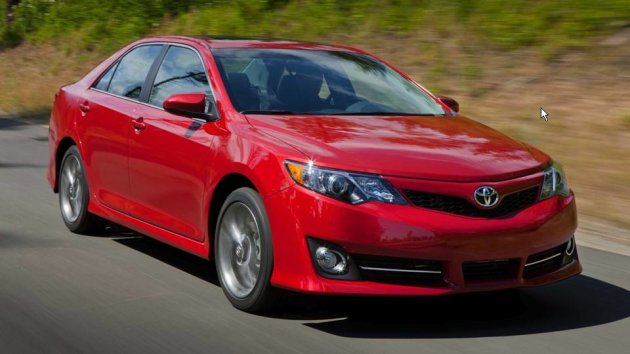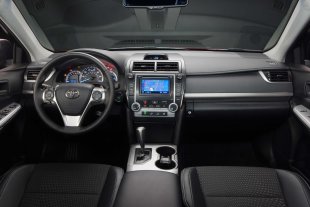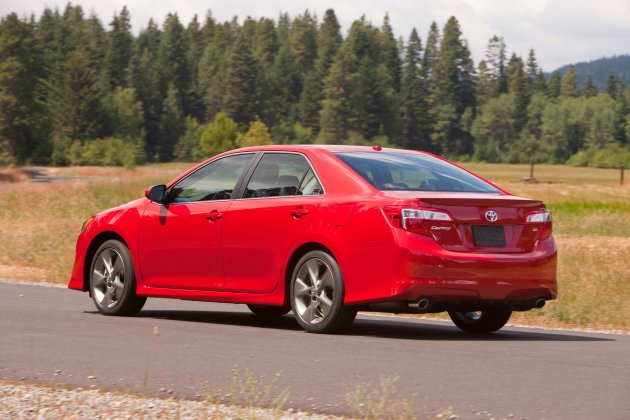
MORE AT YAHOO! AUTOS
The last Camry featured soap-bar styling and a Play-Doh interior that did little to stir the soul. Not that a Camry’s ever been about soul-stirring, per se; but against a fresh crop of quality cars, it seemed dated. Unlike a somewhat subpar effort with the new Yaris, however, the latest iteration of Toyota’s mainstream sedan is a clear example of the company calling all hands to the deck in an attempt to woo back buyers. The result? If you’ve ever liked a Camry before, you’re almost certain to like this one.
That sounds like the sort of faint praise an enthusiast dismissive of the entire class of mid-size sedans would toss off and then suggest that you look into purchasing a vintage Lotus Elite II (a practical hatchback, after all!). But rather than damn the new Camry with faint praise, we’re praising it outright.
In fact, the only member of the new Camry line we’d have a hard time recommending is the sporty SE model ($23,760—$27,400). While it features the best steering of the bunch, the sport-tuned chassis feels out of character with the rest of the car, while the trunk spoiler and chunky 18-inch wheels resemble unfortunate tuner add-on bits. If we wanted a powerful, loaded Camry, we’d go with the V6 XLE ($30,605). The more luxury-oriented variant is still capable of sprinting from stoplight to stoplight or out on the highway — where it will comfortably cruise at extralegal speeds. The four-cylinder L ($22,715) and LE ($26,660) models are perfectly adequate for puttering around town and don’t feel underpowered; they’re classic examples of the family sedan as we’ve come to know it; simply good, solid cars that get 35 mpg on the highway and 25 in the city.
The best of the new Camrys, however, is the thoroughly revised hybrid. For many years, I was a hybrid skeptic. It wasn’t that Toyota’s Hybrid Synergy Drive system didn’t work — it’s that it lent an indirect feel to the vehicle. In something outré like the Prius, it was part of the charm and character of the car. Feeling the gas engine engage and disengage and going from regenerative braking into using the car’s discs for stopping power was all part of feeling good about saving fuel. But the new Camry hybrid barely feels like a hybrid at all. It has a welcome dollop of power over the four-cylinder examples, the regenerative braking is the most seamless we’ve encountered, and at low speeds or in traffic, you’ll be surprised how much time you spend running on electric power. The end result of all this tinkering is a pretty serious uptick in economy over the previous car. While the outgoing model achieved 31 mpg city and 35 mpg highway, the new hybrid gets 39 mpg on the open road and up to 43 mpg around town (41/38 city/hwy mpg for the XLE model).
To achieve over 40 mpg, Toyota resisted the urge to go bigger this time around. In fact, the new car’s external dimensions are exactly the same as the outgoing model’s, though the styling conspires to make the new model look slightly taller and narrower. Toyota refers to this as “Rational Tech-Dynamism,” a term we'd never heard before, either.
In the search for improved on-road dynamism and better economy, Toyota engineers put the new car on a weight-loss program, shaving a couple hundred pounds while judiciously increasing interior volume through the use of re-sculpted seats and a thinner headliner. The interior materials are a drastic step up, and while the company’s attempt to compare the new center stack to a mobile phone in form and function may be hyperbole, it all works well and doesn’t scream “rental car/fleet special” like the last edition. Up-level models are available with Toyota’s new Entune infotainment system, enabling the use of apps like OpenTable, Pandora and iheartradio while on the go.
The emphasis on weight-reduction and fine-tuning is a boon for handling dynamics. While nobody will ever confuse a Camry with a Porsche Panamera, that’s rather beside the point. I found the steering in the pre-production V6 XLE I drove to be maddeningly light at highway speeds, but the tiller in the four-cylinder and hybrid models all had a pleasant, 21st-century family-car feel. I found myself wishing that all of the cars’ electric power steering units had been programmed to respond like the sporty SE’s; the calibration felt just right.
Toyota needed a home run to continue competing in a segment it once owned. The L, LE, XLE and SE will all appeal to current Camry owners and undoubtedly bring some former owners and new buyers into the fold. The hybrid model, however, is currently in a class by itself. If it were my money — and as a Lotus Elite fanatic I rather can’t believe I’m saying this — the hybrid Camry would be the one I’d buy.
Toyota unveils redesigned, lower-priced 2012 Camry
The seventh iteration of the top-selling sedan, which goes on sale in October, must resonate with consumers for Toyota to turn around years of sliding market share.
 Automotive reporters check out the Daytona pace car and hybrid versions of the 2012 Toyota Camry during an unveiling ceremony Tuesday at Paramount Studios in Hollywood. The 2012 Camry hybrid is rated at 41 miles per gallon combined city and highway driving, giving it the best fuel economy of any mid-sized sedan on the market. Toyota has cut the price of the hybrid to $25,900, a $1,150 reduction. (Luis Sinco, Los Angeles Times / August 24, 2011) |
After dominating the U.S. sedan market for more than a decade, Toyota's top-selling Camry has been losing ground to resurgent domestic automakers and upstart Korean manufacturers.
Now, Toyota is fighting back with a lower-priced and fully redesigned 2012 Camry — unveiled with much fanfare Tuesday at Paramount Studios in Hollywood.
Toyota said it was dropping the base price of its core LE Camry model by $200 to $22,500. The more luxurious XLE model will fall by $2,000 to $24,725. They go on sale in October.
"This is an opportunity to show the world what Toyota is all about," Akio Toyoda, the automaker's president, said during a separate event at a Toyota factory in Georgetown, Ky., where the first of the new Camry's rolled off the assembly line.
The Camry has been a hallmark vehicle for Toyota. For nearly a decade, it has been the top-selling sedan in the United States. And it must do well in the marketplace if Toyota wants to reverse several years of declining market share because of a series of massive recalls, production disruptions caused by the Japanese earthquake and aging customers.
Toyoda acknowledged as much, saying, "This car has become a symbol of Toyota's success over the years."
"Toyota is very hungry to win back consumer confidence and regain the leadership in that car segment," said Michelle Krebs, an analyst with auto information company Edmunds.com. "They have to be aggressive in pricing because they are no longer in a position where they can charge a big premium."
The new model is the seventh iteration of the Camry and the first redesign of the sedan since the 2007 model year. IHS Automotive expects it to do well, forecasting that the new version will sell 350,000 to 380,000 vehicles during its first year.
The new Camry features a 2.5-liter, four-cylinder engine that produces 178 horsepower, a 5% increase from the current model. The fuel economy is rated at 28 miles per gallon combined city and highway driving, up from 26 mpg for the 2011 model. Toyota also will offer a six-cylinder version that's expected to make up around 15% of sales.
The new Camry hybrid is rated at 41 miles per gallon, giving it the best fuel economy of any mid-sized sedan on the market. Toyota has cut the price of the hybrid to $25,900, a $1,150 reduction.
Toyota said the new models will offer a sportier drive with tighter suspension and handling. The car also will include 10 air bags to protect the driver and passengers.
Although Toyota has taken an "aggressive" pricing stance, the company isn't about to set hearts fluttering with Camry's new styling. The 2012 model looks a lot like the car it replaces, Krebs said.
"It is very typical of Toyota to not go out on a limb when it comes to styling. Styling is not the reason why people buy the car," she said.
For Toyota to rebound from its sales slide, "it is extremely important for them to get this car right," said Rebecca Lindland, an analyst with IHS Automotive.
Sales of the company's flagship Toyota brand in the U.S. have fallen almost 6% this year through July, a period during which auto sales overall have climbed almost 11% from a year earlier, according to Autodata Corp. The brand's market share has fallen to 11.4% from 13.4%, the biggest drop of any major nameplate. And that follows a big dip in 2010.
The Camry's market share in the mid-size car segment so far this year is 13.8%. That's down from a share of 16.5% in 2010 and a peak within the last decade of 18.8% in 2009, according to Edmunds.com.
Until recently, Toyota and Honda, the two biggest Japanese brands in America, were considered the default choices for sedan buyers. But that's changed as U.S. automakers restructured their businesses and put a renewed emphasis on designing fuel-efficient passenger cars.
General Motors' Chevrolet Cruze now outsells Toyota's Corolla and Honda's Civic in the compact car segment, and the Ford Fusion sedan cracked the top 10 list of vehicle sales last year. At the same time, Korean manufacturers Hyundai and Kia unveiled new versions of their respective Sonata and Optima mid-sized sedans that are selling briskly. The Nissan Altima also is gaining share, and has narrowed its sales gap with the Camry.
One reason brands other than Toyota and Honda are gaining ground is the willingness of younger buyers to consider manufacturers that their baby boomer parents avoided.
"We are really seeing the market starting to change," Lindland said. "Consumers are really looking around, and they aren't just going in and buying a white Toyota Camry with a beige interior."
Sphere: Related Content
![Validate my Atom 1.0 feed [Valid Atom 1.0]](valid-atom.png)
































































Nenhum comentário:
Postar um comentário